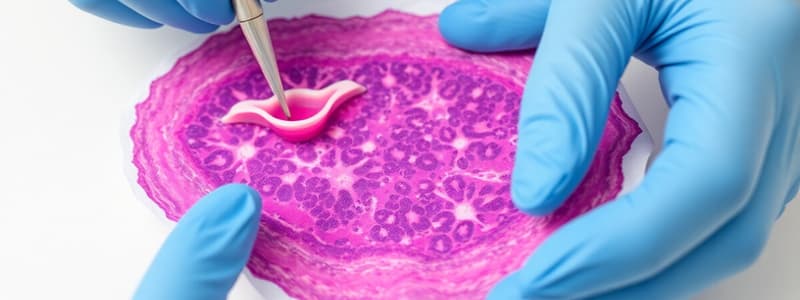Podcast
Questions and Answers
What is the primary purpose of tissue processing?
What is the primary purpose of tissue processing?
- To freeze the tissue for later use
- To remove water and allow for thin section cutting (correct)
- To preserve the color of tissues
- To maintain the original shape of the tissue
Which reagent is most commonly used for dehydration of tissue?
Which reagent is most commonly used for dehydration of tissue?
- Ethanol (correct)
- Methanol
- Acetone
- Formalin
Why is dehydration necessary before infiltration in tissue processing?
Why is dehydration necessary before infiltration in tissue processing?
- Water enhances the staining process
- Water must be removed as it does not mix with non-aqueous media (correct)
- Water causes the tissue to swell
- Water mixes well with embedding media
In which step of tissue processing is paraffin wax introduced?
In which step of tissue processing is paraffin wax introduced?
What happens during the clearing step of tissue processing?
What happens during the clearing step of tissue processing?
What happens to tissues when the dehydration process is too rapid?
What happens to tissues when the dehydration process is too rapid?
At what concentration does dehydration typically begin?
At what concentration does dehydration typically begin?
What must be done to tissue sections after cutting them for staining?
What must be done to tissue sections after cutting them for staining?
What is the primary purpose of adding softenings such as phenol or glycerin to a dehydrant?
What is the primary purpose of adding softenings such as phenol or glycerin to a dehydrant?
Which of the following is considered one of the best clearing reagents?
Which of the following is considered one of the best clearing reagents?
What are the two processing reagents a universal solvent must be miscible with?
What are the two processing reagents a universal solvent must be miscible with?
What is the result of leaving a clearing agent in contact with tissue for too long?
What is the result of leaving a clearing agent in contact with tissue for too long?
Which characteristic do most clearing agents change in tissue?
Which characteristic do most clearing agents change in tissue?
Which one of the following is NOT a criterion for choosing clearing agents?
Which one of the following is NOT a criterion for choosing clearing agents?
What is a significant disadvantage of using xylene as a clearing agent?
What is a significant disadvantage of using xylene as a clearing agent?
Which advantage is associated with toluene as a clearing agent?
Which advantage is associated with toluene as a clearing agent?
What is a prominent risk associated with long-term exposure to toluene?
What is a prominent risk associated with long-term exposure to toluene?
Which characteristic makes benzene a preferable option over toluene despite its higher hardening effect?
Which characteristic makes benzene a preferable option over toluene despite its higher hardening effect?
What is the primary role of infiltration media in tissue processing?
What is the primary role of infiltration media in tissue processing?
Which of the following is NOT a commonly used infiltration medium?
Which of the following is NOT a commonly used infiltration medium?
What is a significant advantage of using paraffin as an infiltration medium?
What is a significant advantage of using paraffin as an infiltration medium?
What effect does adding beeswax to paraffin have?
What effect does adding beeswax to paraffin have?
Which statement is true regarding the melting temperature of proprietary paraffin?
Which statement is true regarding the melting temperature of proprietary paraffin?
What is a disadvantage of using an open tissue processor?
What is a disadvantage of using an open tissue processor?
What pressure should not be exceeded when infiltrating paraffin under pressure?
What pressure should not be exceeded when infiltrating paraffin under pressure?
Which characteristic of paraffin allows many different staining procedures?
Which characteristic of paraffin allows many different staining procedures?
What is the purpose of using graded concentrations of alcohol during dehydration?
What is the purpose of using graded concentrations of alcohol during dehydration?
Which dehydrating reagent is most commonly used for tissue processing?
Which dehydrating reagent is most commonly used for tissue processing?
What is a potential disadvantage of prolonged exposure to ethyl alcohol during dehydration?
What is a potential disadvantage of prolonged exposure to ethyl alcohol during dehydration?
Which of the following is a safety concern related to the use of alcohols in the lab?
Which of the following is a safety concern related to the use of alcohols in the lab?
What is the main concern when using acetone as a dehydrating agent?
What is the main concern when using acetone as a dehydrating agent?
What specific property of isopropanol makes it less effective for celloidin embedding?
What specific property of isopropanol makes it less effective for celloidin embedding?
When verifying alcohol content during dehydration, what happens if the mixture with xylene-water turns white?
When verifying alcohol content during dehydration, what happens if the mixture with xylene-water turns white?
Which of the following is NOT a characteristic of ethyl alcohol as a dehydrating agent?
Which of the following is NOT a characteristic of ethyl alcohol as a dehydrating agent?
What is the recommended initial concentration of alcohol for dehydrating delicate tissues?
What is the recommended initial concentration of alcohol for dehydrating delicate tissues?
Which is a characteristic commonly associated with denatured alcohol for laboratory use?
Which is a characteristic commonly associated with denatured alcohol for laboratory use?
Flashcards
Tissue Processing
Tissue Processing
Removes water from tissues, replacing it with a solidifying medium for thin sectioning.
Dehydration (Tissue)
Dehydration (Tissue)
Removes water from the tissue using a series of increasing ethanol concentrations.
Common Dehydrating Agent
Common Dehydrating Agent
Ethanol (alcohol).
Why Dehydration?
Why Dehydration?
Signup and view all the flashcards
Clearing (Tissue)
Clearing (Tissue)
Signup and view all the flashcards
Common Clearing Agent
Common Clearing Agent
Signup and view all the flashcards
Infiltration (Tissue)
Infiltration (Tissue)
Signup and view all the flashcards
Common Infiltration Media
Common Infiltration Media
Signup and view all the flashcards
Paraffin Wax Benefits
Paraffin Wax Benefits
Signup and view all the flashcards
Paraffin Wax Additives
Paraffin Wax Additives
Signup and view all the flashcards
Paraffin Melting Temperature
Paraffin Melting Temperature
Signup and view all the flashcards
Open Tissue Processors
Open Tissue Processors
Signup and view all the flashcards
Safety Precautions
Safety Precautions
Signup and view all the flashcards
Study Notes
Tissue Processing
- Tissue processing aims to remove water from tissues and replace it with a medium that solidifies to allow thin sections to be cut.
- Three major steps in tissue processing include dehydration, clearing, and infiltration.
Dehydration
- Dehydration removes water from the tissue.
- The most common dehydrating agent is ethanol.
- Dehydration uses a gradual increase in ethanol concentration (50%, 60%, 70%, 80%, 90%, 100%) to minimize shrinkage and distortion.
Dehydration: Why is it Important?
- Dehydration is necessary because water does not mix with infiltrating or embedding media (e.g. paraffin, celloidin).
- Ethanol is miscible with both water (from fixative) and clearing agents (e.g. xylene).
- Dehydration is also performed after staining because most stains are aqueous and water does not mix with resinous mounting media.
- After embedding, cutting, and drying, slides are deparaffinized and hydrated before staining.
Clearing
- Clearing removes alcohol from the tissue and replaces it with a clearing agent (dealcoholization).
- Clearing agents must be miscible with dehydrating alcohols, infiltrating media (e.g. paraffin), and mounting media.
- Many clearing agents change the refractive index of tissue.
Common Clearing Agents
- Xylene is considered one of the best clearing agents.
- Other clearing agents include toluene, benzene, chloroform, acetone, essential oils (e.g. cedarwood oil), and xylene substitutes (e.g. limonene, clearite).
- All clearing agents are very toxic.
Infiltration
- Infiltration media is added to the tissue to add support.
- The media helps to hold cells and intracellular structures in proper formation during the cutting stage.
Common Infiltration Media
- Paraffin wax is the most common infiltration media.
- Other options include water-soluble wax, celloidin, plastics, and epoxy resin.
Paraffin Wax
- Paraffin is cheap, easy to handle, and allows for relatively easy section production in a short time.
- Paraffin allows for serial sectioning, many staining procedures, and immediate storage after cutting.
- Paraffin is also safe to handle.
Paraffin Wax Additives
- Additives change the properties of paraffin wax. For example:
- Beeswax increases stickiness.
- Rubber reduces brittleness.
- Other waxes smooth texture and reduce crystal size.
- Plastic increases hardness and support.
Proprietary Paraffin
- Paraffin with an increased melting temperature indicates a harder wax formula.
- Harder waxes allow thinner sectioning but make ribboning difficult.
- Paraffin with a decreased temperature results in softer wax, better ribboning, but it is harder to get very thin sections and less tissue support.
- Most labs use paraffin with a lower melting point (55-58 °C).
Tissue Processors
- Tissue processors can be open or closed.
- Open processors are “Dip and Dunk” processors that automatically move tissue cassettes through various reagent containers.
- Open processors require more time, are more hazardous, and are prone to errors.
Safety
- All alcohol and clearing agents are flammable.
- Alcohol may cause violent reactions with oxidizing agents.
- Ethyl alcohol is intoxicating.
- Methyl and isopropanol are poisonous.
- Dispose of alcohol properly.
- All clearing agents are very toxic.
- Use proper ventilation, gloves, and waste disposal techniques.
- Automation of coverslipping can reduce exposure to toxic chemicals.
Studying That Suits You
Use AI to generate personalized quizzes and flashcards to suit your learning preferences.




